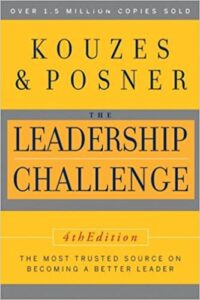

Introduction
The Leadership Challenge is a book on leadership. I read the fourth edition but the latest version is the sixth edition. This book is about how to turn challenging opportunities into remarkable successes. It aims to help the readers to develop the capacity to guide others to places they have never been before.
Authors
James Kouzes is the Dean’s Executive Professor of Leadership, Leavey School of Business, Santa Clara University. He is a Fellow of the Doerr Institute for New Leaders at Rice University. He is acknowledged as one of the twelve best executive educators in the US by The Wall Street Journal.
Barry Posner is the Accolti Endowed Professor of Leadership at the Leavey School of Business, Santa Clara University. He has been named as one of the nation’s top management and leadership educators by the International Management Council, recognized as one of the Top 50 leadership coaches in America, ranked among the Most Influential HR thinkers in the world by HR magazine, and listed among the Top 75 Leadership and Management Experts in the world by Inc. magazine.
Contents
The Leadership Challenge has a preface (Getting Extraordinary Things Done in Organization) and 13 chapters. The chapters are grouped into 7 parts.
Part 1 is What Leaders Do and What Constituents Expect. The 2 chapters here are The Five Practices of Exemplary Leadership, and Credibility is the Foundation of Leadership.
Part 2 is Model the Way and contains 2 chapters. These are Clarify Values, and Set the Example.
Part 3 is Inspire a Shared Vision and consists of Envision the Future, and Enlist Others.
Part 4 is Challenge the Process. It contains 2 chapters. They are Search for Opportunities, and Experiment and Take Risks.
Part 5 is Enable Others to Act. The 2 chapters here are Foster Collaboration, and Strengthen Others.
Part 6 is Encourage the Heart and is made up of Recognize Contributions, and Celebrate the Values and Victories.
Part 7 is Leadership for Everyone and has only 1 chapter. This chapter is Leadership Is Everyone’s Business.
Review
First, let’s define what is a leader. According to the authors, a leader brings out the best in others and guides them to accomplish exceptionally challenging goals. The 4 key characteristics of a leader are honest, forward-looking, inspiring, and competent.
The Leadership Challenge recommends practices that are all evidence-based. It uses kaizen approach, which approaches change through incremental steps and small wins. We need changes because we simply cannot expect different result by doing things the same way.
The 5 practices in the book are model the way, inspire a shared vision, challenge the process, enable others to act, encourage the heart. Each practice has 2 commandments, which correspond to the chapters in Part 2 to 6. The authors also provide the action steps for each commandment in its chapter.
Leadership is a relationship between those who aspire to lead and those who choose to follow. The authors call the people who choose to follow as constituents, instead of followers. Leaders must be credible to engender loyalty, commitment, energy, and productivity. Credibility is not just a promise, but also the ability to deliver on the promise.
Leaders must be clear about personal values too. To step into the unknown, we should begin with the exploration of the inner territory. Be true to yourself because people prefer to see who you are, the real you. Without trust, we cannot lead.
To lead, we also need to have shared values with our constituents. How do we set shared values? By listening, appreciating, building consensus, and practicing conflict resolution. Asking others’ opinion facilitates participation in decisions and increases support for that decision. Good themes for organizational values include high performance standards, a caring attitude about people, a sense of uniqueness and pride.
Leaders have to walk the talk. You must do what you are asking of others. People are watching everyone in the organization. Rewards and recognition could help to reinforce the values. Nonetheless, what we choose to reinforce is what people will choose to value. Rewards are most effective when they are highly specific and given in close proximity to the appropriate behaviour. Celebrations have two purposes which are to honor a principle or an achievement, and to create community.
Everyone needs a sense of meaning and purpose and leaders help people see that what they are doing is bigger than themselves and bigger, even, than the business. A leader needs to find the passion because there is no one more believable than a person with a deep passion for something. It is the precursor to compassion.
Leadership is an affair of the heart. The secret to successful leaders is love, and leaders also do not mind losing arguments in favor of the common good. If you think you are unfit to be a leader, just remember this: Excellence in anything requires disciplined practice. By practicing the commandments in the book, we can surely become a leader.
Let’s end with Kouzes-Posner Laws of Leadership. The first law is if you don’t believe in the messenger, you won’t believe the message. The second law is DWYSYWD: do what you say you will do.
Quotes
- The abundance of challenges is not the issue. It’s how we respond to them that matters.
- The first place to look for leadership is within yourself.
- Leadership is not about personality; it’s about behavior.
- Leaders cannot command commitment, only inspire it.
- Leadership is a dialogue, not a monologue.
Rating
[usr 3]
Interested in The Leadership Challenge?
You may get the book from through the link below*.
Get the print book from Kinokuniya Malaysia here
*Disclosure: The above link is an affiliate link. Thus, I may earn a small commission when you purchase the book through the link.



[…] The Leadership Challenge is a good book to develop the readers’ leadership skill. Leadership is a skill that can be learned and developed, not an innate ability. The authors provide clear steps for us to follow and these are all evidence-based. If you have the chance, perhaps you could get the latest version (the sixth), instead of the one that I read. […]